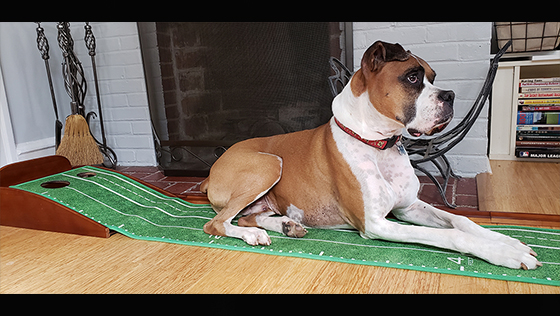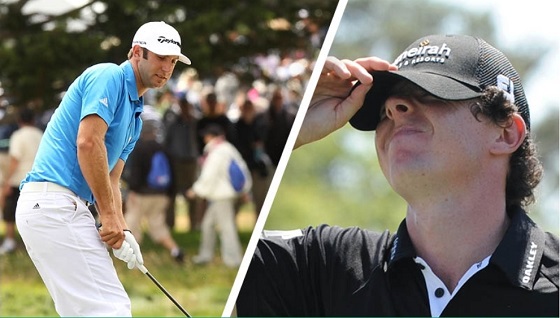Blog
The Father-Son Trip of A Lifetime – Golf, Bonding & a Trip That Will Never Be Forgotten…

This article was written by the CEO of ClickitGolf – Jeff is an avid golfer, golf enthusiast, and one hell of a business partner.
BACKGROUND:
In this article, we walk you through the type of golf trip that enforces that coveted father /son relationship, moreover, the kind of trip that can significantly change lives and relationships forever. I assume we have your attention… Great, Mission #1 accomplished ✅ – Keep reading to see how it all went down!
In all honesty, and after some reflection, I am doing this as much for me as I am for you, my readers, so THANK YOU! I will truly re-live this trip and the memories we made every time I read this piece. Also, unselfishly, I hope it inspires… Inspires you to do something similar with someone special in your life sooner than later. It doesn’t have to be golf – it can be hiking, camping, tennis, pickleball – shoot – pick your narrative really! Whatever your heart desires, make it happen – it will undoubtedly bring you closer to someone you share a similar passion with. So… In the words of Phil Knight… “Just Do It”.
It seems these days we blink and another year goes by. You know what they say…each day wasted, is one that we can never get back. With that, I decided that this was our Summer. It was weird how it happened. We looked at each other after dinner one night, and as if we both had an out-of-body experience mind melt, we just knew It was on! Furthermore, my ClickiGolf partner had been pushing me to do it and thought our readers might enjoy experiencing it right along with us. So we did, we kept a journal and took pictures. This article is the direct outcome of making a dream a reality. Ready – Let’s go!
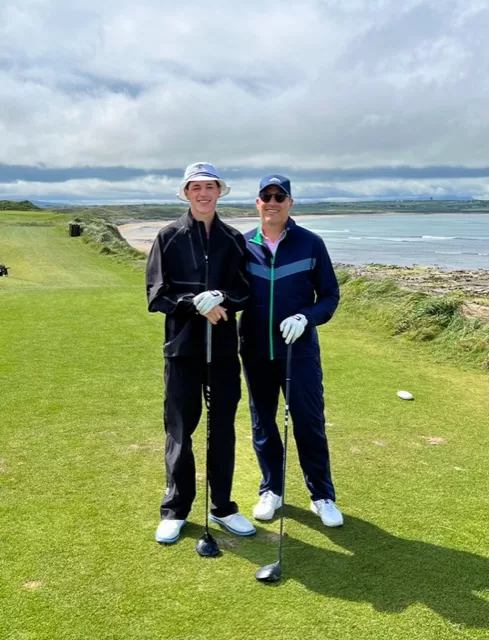
INTRODUCTION:
Recently, I embarked on one of those trips of a lifetime with my 18-year-old son Andrew. Both being avid golfers, we journeyed to Ireland to play five of the most famous golf courses in the world. Now, he may have the old man’s number now, but just a few short years ago, I could give him 5 a side and feel comfortable. Dylan said it best… The times they are a-changin’ – and boy – was he right then and oddly enough those words seem to resonate even more so now…
We all have that “bucket list” we want to check off during our life. I am so lucky to have just checked off one of the boxes. You know, the one you dream of, but deep down aren’t sure will ever really happen. Well, this one, I have been dreaming of for decades – and I’ll be damned, even as I write this, on the plane back from Ireland, I am questioning if it was real or all some sort of elaborate visceral lucid dream… OUCH – the flight attendant passed me with her cart filled with tonic water and bags of peanuts. I have an aisle seat, my right elbow was just bumped by said snack cart, and the tingling in my “funny bone” is letting me know – HOLY SH*T – this trip WAS REAL! I digress…
Itinerary: a 12-hour transatlantic flight to a far-off land. Just a dad and his only son embarking on an adventure of a lifetime. Our goal: Taking off for the iconic golf heaven named Ireland. This will be the kind of golf trip that will kick start one person’s life & college career while simultaneously bookending a significant chapter for the other. A proud father and now, a new empty nester… Thank you for taking this journey with me. Here goes…
HOW IT CAME TO BE:
A little background – I’m an 8 handicap and my son is a 1 handicap and played high school golf in Florida; Andrew did receive some offers to play college golf at various d2 and d3 schools, but has chosen to study hard and hopefully meet some cute college co-eds! (I hope in that order).
We had planned this trip over 18 months ago because getting onto these courses is extremely difficult (especially following Covid-19) when many golfers were forced to cancel travel and rebook the following year.
I am very fortunate to be happily married for 30 years and have 3 great children. My wife also loves golf and my oldest daughter, now 26 was a competitive golfer in high school and now plays for fun when she finds the time. Initially, we would have opted for a “family trip” to Ireland however my middle child, Lexi (age 23) has no clue how to hit a golf ball. I still love her but why couldn’t she learn golf instead of tennis when she was a kid? Thus, the rationale for the father/son trip!
As I learned, there are 2 regions of Ireland for golf – (1) the North and (2) the South. Although not horribly far by car (around 6 hours), most golfers will pick one region of Ireland and then plan a follow up a follow-up trip to return.
We chose the Southern Region and booked these 5 courses:
- Old Head Golf Links
- Tralee Golf Club
- Hogs Head Golf Club
- Ballybunion – The Old Course
- Waterville Golf Club
Andrew did want to travel to the North to play 2 very famous courses (1) Royal County Downs and (2) Port Rush – both courses considered top 10 in the world. However, it wasn’t in the cards for this trip so it gives us the best excuse to hopefully go back in the future.
THE COURSES AND OUR RANKINGS:
Old Head ⭐⭐⭐⭐⭐– called the Pebble Beach of Ireland. And it certainly was. We were blown away by the views. Our caddie at Old Head (and candidly at every course) was beyond incredible.

Tralee ⭐⭐⭐⭐ – I hadn’t really heard of this course in depth prior to the trip. What a course. Maybe the most beautiful back 9 on Earth. Built into the water on every hole.

Waterville ⭐⭐⭐⭐– One of the oldest courses in Ireland and the home of the Irish Open a few years back. Just a month earlier, Adam Scott and Shane Lowry played there. As we’re checking in with the starter, a very friendly Irish gentleman about 80 years old says “Andrew – you look like a good golfer?” Andrew quickly says “You look pretty good yourself” as you just get a different energy and can somehow tell that this guy was “a player.” We started talking and we introduced ourselves (I’ve trained Andrew you always take your hat off, offer a firm handshake, and look the person directly in the eye). “Nice to meet you says Lee Higgins”. I thought to myself, I remember that name somehow…but how…who was this Lee Higgins character – ? click to find out – crazy story! After a lengthy conversation, we learn that Lee Higgin’s, now 81 years, home course is Waterville Golf Links, won 6 times on tour and was runner-up 5 other times. And, for a really cool trivia fact – Higgins set the world long-drive record in 1984 hitting a ball 634 yards on the runway at Baldonnel Military Airport in Dublin.

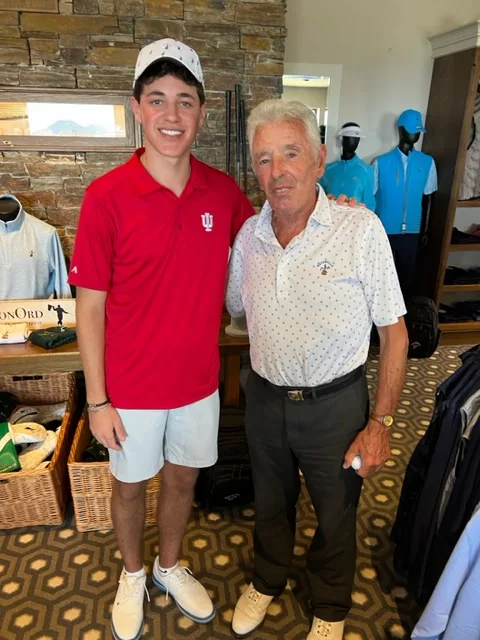
Hogs Head ⭐⭐⭐⭐– Candidly, I had never heard of this course prior to making our trip but my golf travel agent had highly recommended it and was so excited that she got us on. A billionaire from the USA who attended the University of Michigan (the alma mater of my oldest daughter) built this course. It was truly incredible and because of the “Michigan connection”, I spent more money than I should have on all the blue and maize logoed items in their pro shop! Hoags Head is located just a few minutes from Waterville Golf Club.

BallyBunion Golf Club ⭐⭐⭐⭐⭐– Ranked one of the top courses in the world and I can see why. Tom Watson considers this his favorite course in the entire world. My son being a 1 handicap, wanted to play the tips vs. my typical yardage which is my distance on my home course. The Caddie says to Andrew – play your dad’s tees! You will have a lot more fun. And he was absolutely right! With the windy conditions and tricky terrain, this was the way to go! The caddies are always right. It’s crazy – Like ALWAYS! – They have knowledge that is passed down from generation to generation. Without them, we both agreed we would have shot 5+ strokes worse on every round.

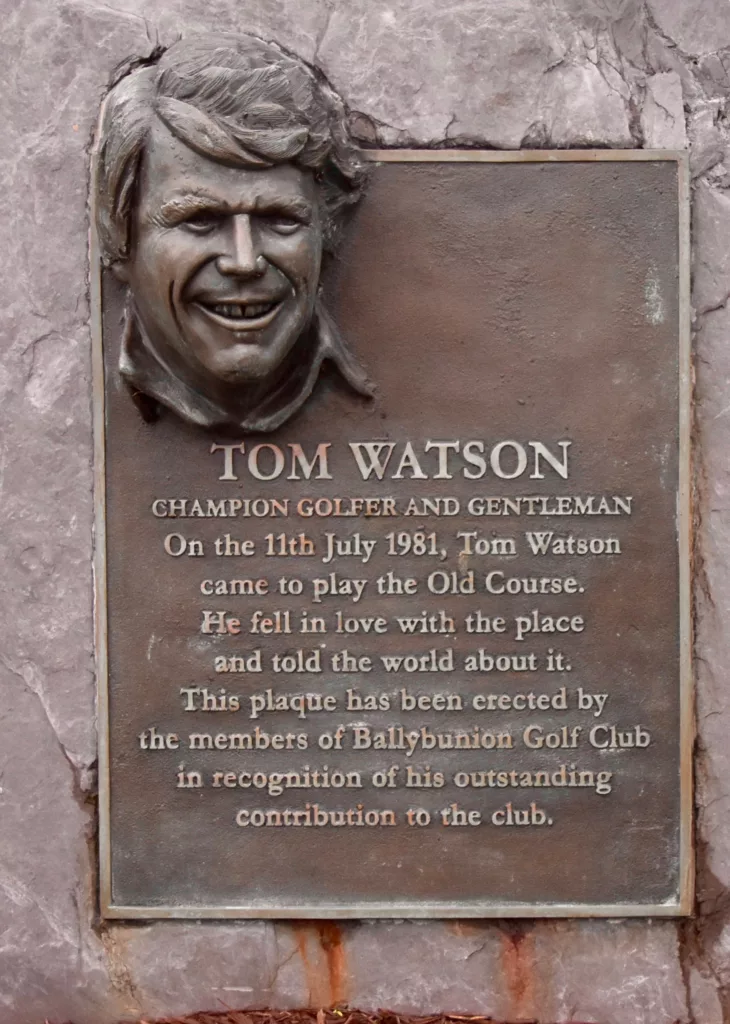
THE WEATHER:
My Rainsuit – all I heard prior to leaving was “be prepared” for the rain. I have become quite spoiled as I live on a golf course and with just the site of a few drops of rain, “I’m done” and happy to go back to my house and have a catch with my dog. However in Ireland, with the cost of the greens fees, we’re playing 18 holes even if it’s a monsoon. I purchased a VJUS rainsuit – it cost more than my wedding celebration but I was prepared for the elements. Plus I brought a really cool umbrella that wouldn’t turn upside down even in winds up to 1,000 mph. I also had 2 rain gloves and brought 2 pairs of golf shoes in case mine were soaked from the prior day. Guess what? It never rained in 7 straight days. Not one drop. Zero. The caddies said “lads – you got so lucky.” My rain suit is now hanging and unworn in the back of my closet.
THE CADDIES:
They were the best on so many levels. (1) I think I would have lost a million balls without their eyes; (2) You must trust them implicitly which I learned very quickly. One caddie had a bottle of bourbon in his pocket and on every hole took a quick sip. My son quickly stopped drinking his water and now is a connoisseur of bourbon To recall a funny caddie story: – I carry a 4 iron which I hit about 190 yards – but I’ve recently started using my 4 hybrid which I hit more often. My drive on the 14th hole at Tralee was in the middle of the fairway leaving me the perfect 4 iron. The Caddie now knowing my game perfectly after prior 13 holes pulls out the 4 iron. I said “I don’t hit the 4 iron”; his immediate response without taking a breath was “Why the Fu** am I then carrying your 4 iron?” I felt slightly embarrassed and of course, hit the 4-iron onto the green. We got a good laugh, drank a bit more, and started walking down the fairway. He said, “I’ll pull out which club you should hit from now on – no need for you to look at which club it is – just hit it – Trust me, Lad”. He was right. What an amazing and cool guy, he was making our round even better and so much fun!
DRIVING:
Driving in Ireland – This was my first trip to Ireland. I loved the people; I loved the scenery. I loved the golf. I hated one thing -the driving!! Because we were just a 2-some, we opted to save some money and rent a car (vs. a typical group of 8 or 12 golfers) who will rent a van for the week with a driver. In short, I have never been so scared in my life driving on these roads. Driving on the “other” side of the street was ok and relatively easy to learn (except for all the roundabouts). However, on these tiny backroads where most of the courses are located, they say 2 cars can fit, (like in the USA,) but I can assure you…ONLY ONE CAR fits even somewhat comfortably. Each time a van, bus, or truck passed me, I had to veer to the shoulder to stop from being hit. BONUS: I did get a flat tire in the middle of nowhere. Thankfully Andrew could figure out google maps and contacted an AAA-type company that eventually got us a new tire and back on the roads. My 2 cents – get a driver! It will save you the stress of driving in a foreign land and save you some grey hair while trying not to die abroad. If you do drive – give yourself a good 30 min buffer as to when you leave for the tee time. Trust me, you WILL need it.
REFLECTION:
As I reflect on our trip, it was without question, the trip of a lifetime I had hoped it would be…….. Having my only son, Andrew, alone for a week of golf, laughs, dinners, drinking, and just strengthening our “father/son friendship was one of the most special experiences of my life. It gave me a stark reminder not to blink – they grow fast…way too fast these days. So if you are close to having one of yours go off to school or just looking to re-kindle that relationship with a child, loved one, or just some of the old crew of golf buddies. There is no time like the present. It’s a gift – hence the term “the Present ?” As cheesy as it sounds when I proof this, I chose to keep it. It’s real. Cherish every moment…
CHEERS
Blog
Sustainability in Golf: The Future of Eco-Friendly Greens
Read about the environmental impact of golf courses.

Golf, a sport often associated with pristine, manicured greens and lush landscapes, isn’t historically perceived as eco-friendly. However, with growing concerns about climate change and sustainability, the golf industry is steadily transitioning towards more sustainable practices. This article will explore how golf courses around the world are becoming greener and more eco-friendly while maintaining their appeal to golf enthusiasts.

The Environmental Impact of Golf Courses
Golf courses traditionally use extensive resources, including water, pesticides, and fertilizers, which can have detrimental effects on the environment.
-
-
- Water Usage: Maintaining the verdant landscapes of a golf course requires enormous amounts of water. This is particularly concerning in regions where water scarcity is a significant issue.
- Pesticides and Fertilizers: To keep golf courses lush and free of pests, large amounts of chemicals are often used. These substances can seep into the ground, polluting water sources and harming local wildlife.
- Habitat Disruption: Golf courses often displace natural habitats, upsetting local ecosystems and reducing biodiversity.
-

Green Initiatives in Golf: Sustainability on the Fairways
Recognizing the environmental impact, many golf courses are now implementing sustainable practices to reduce their ecological footprint.

Water Conservation
Water conservation is a significant focus in eco-friendly golf course design. Methods employed include:
-
-
- Recycled Water: Many golf courses are now using recycled water or rainwater for irrigation, significantly reducing the use of freshwater resources.
- Drought-resistant Grass: Some courses are opting for drought-resistant varieties of grass that require less watering.
- Irrigation Technology: Advanced irrigation systems can efficiently distribute water, minimizing waste.
-

Reducing Chemical Usage
Reducing the use of harmful chemicals is another crucial step towards sustainability in golf. This can be achieved through:
-
-
- Organic Fertilizers and Pesticides: Many golf courses are switching to organic alternatives, which are less harmful to the environment.
- Integrated Pest Management: This approach focuses on long-term prevention of pests through biological control and habitat manipulation, reducing the need for chemical pesticides.
-

Preserving Local Habitats
Golf courses are increasingly being designed to coexist harmoniously with local ecosystems. This involves:
-
-
- Preserving Natural Features: Instead of altering the landscape to fit the course, designers are now incorporating existing natural features into the design.
- Creating Wildlife Habitats: Some golf courses are creating habitats for local wildlife, promoting biodiversity.
-
Case Studies: Sustainable Golf Courses Around the World
There are several golf courses worldwide that serve as excellent examples of sustainability in the industry.
- Pebble Beach Golf Links, USA: This renowned golf course uses recycled water for irrigation, reducing its freshwater use by 50%.
- St Andrews Links, Scotland: Known as the “Home of Golf”, St Andrews Links has implemented an extensive environmental management plan, including water conservation, habitat protection, and the use of organic fertilizers.
- Vineyard Golf Club, USA: This golf course in Massachusetts is one of the first to become fully organic, using only organic fertilizers and pesticides.
The Future of Sustainable Golf
The golf industry’s move towards sustainability is not just about eco-friendly practices on the course. It’s also about educating players and visitors about the importance of sustainability, thus promoting a culture of environmental consciousness.
While the transition to greener practices may be challenging, the benefits are immeasurable. Sustainable golf courses not only help protect the environment, but they can also enhance the playing experience, offering golfers the chance to play their favorite sport while surrounded by thriving, natural landscapes.
In conclusion, as awareness of environmental issues continues to grow, the question of “how green can the greens get?” is being answered by golf courses worldwide. Through innovative practices and a commitment to sustainability, the future of golf looks set to be greener than ever. As players, supporters, and enthusiasts of the sport, we can all contribute to this positive change by supporting golf courses that prioritize sustainability and by advocating for green practices within the golfing community.
Blog
The Golfer’s Holiday Hint-Dropping Guide
Your spouse thinks you want socks. You want a new driver. Here’s how to fix that.

Because subtlety is overrated when there’s a new driver on the line
Your spouse thinks you want socks.
Your kids think you want a tie.
Your mother-in-law is convinced you’d love another sweater with a reindeer on it, even though you’ve worn the last three exactly never, and everyone knows it, but somehow this year will be different.
It won’t be.
Here’s the problem. You want golf stuff. They don’t know what golf stuff means. You say “rangefinder” and they hear “robot finder.” You mention “premium golf balls” and they think all golf balls are the same, which is adorable but wrong, and you can’t exactly explain that without sounding like a crazy person who cares too much about dimple patterns.
So you need a strategy.
Not a subtle one either. Forget dropping hints like breadcrumbs. Drop them like anvils. We’re talking about a systematic campaign of suggestion, repetition, and strategic device-leaving that would make Madison Avenue jealous.
The Laptop Strategy (For the Tech-Savvy Golfer)
Leave your laptop open. Always. But not to just anything.
Open to golf retailer websites with items in your cart. Specific items. With the size, color, and model number clearly visible. And here’s the key – leave it open on the kitchen counter where your spouse makes coffee, because everyone looks at screens while waiting for coffee, it’s basically a law of physics at this point.
Do this for three weeks straight. Different items, same cart. They’ll get the message. And if they don’t, you’ve got a backup plan because you can just buy it yourself on December 26th when everything goes on sale.
The Casual Mention Method
This requires finesse.
Not too much though.
The goal is to work golf gifts into every conversation without seeming obsessed, which you are, but they don’t need to know that. Your daughter mentions her science project? “Speaking of projects, I’ve been thinking about upgrading my wedges.” Your son talks about his basketball shoes? “Funny you mention shoes – golf shoes with better traction would really help my game.” The mailman asks how you’re doing? “Great, though I’d be better with a new putter.”
Is this overkill? Maybe. Will it work? Absolutely.
The Magazine Massacre
Buy every golf magazine on the newsstand. Dog-ear the pages. Circle items in red pen. Write notes like “This would be perfect!” and “Honey, look at this one!” and leave them everywhere – the bathroom, the nightstand, the kitchen table, the car, their car, basically anywhere someone might sit for more than thirty seconds.
When they ask why there are seven golf magazines in the living room, just smile and say you’re “doing research.” Research for what? They won’t ask. They’re too busy looking at all those circled items with price tags helpfully highlighted.
The Strategic Screenshot
Text them screenshots. Daily.
“Look at this cool driver!” Send.
“These gloves are on sale!” Send.
“Remember when I mentioned wanting new golf shoes? These are the ones.” Send with three heart emojis because you’re not a monster, you still care about the relationship, you just also care about having the right equipment to shave three strokes off your game.
It’s called balance.
The Gift List That’s Not a Gift List
Create a shared note on your phone called “Gift Ideas” and fill it exclusively with golf items. When they ask what you want for Christmas, just say “Oh, I don’t know, I’m easy to shop for!” and then casually mention you made a little list of ideas, you know, just in case they needed inspiration, no pressure, but it’s organized by price range and includes links.
This works because you’re giving them exactly what they want – a clear shopping list – while maintaining the illusion that you’re being flexible. You’re not. But they don’t need to know that until after the presents are wrapped.
The Buddy System
Recruit your golf buddies. Have them “accidentally” call when your spouse is around. Make sure they loudly discuss the new equipment they just bought and how much it’s improved their game. Your spouse will hear. They’ll connect the dots. And if they don’t, have your buddy call again tomorrow. And the next day. Eventually, either your spouse will buy you golf stuff or they’ll buy you a different phone number, and honestly, both outcomes have their merits.
The Amazon Wish List Blitz
Create an Amazon wish list. Share it with everyone. Your spouse, your kids, your parents, your siblings, your coworkers, that guy you met at the driving range once, everyone.
Put forty items on it. Thirty-eight should be golf-related. The other two? A book and a candle, just so you seem reasonable and well-rounded, which you’re not, but again, they don’t need to know that.
Update it weekly. Add reviews in the comments like “Would really help my slice” or “These are the exact ones my pro recommended.” Make it impossible for them to buy anything else because everything else looks boring compared to golf equipment that promises to transform your game, which it might not, but the promise is what matters here.
The Direct Approach (For the Brave)
Just tell them.
Seriously.
Sit them down. Look them in the eyes. Say “I want golf stuff for Christmas. Specifically, I want this driver, these balls, and this rangefinder. Here are the links. Here are the specs. I’ve made it as easy as possible. Thank you for listening to my TED talk about my golf needs.”
Will they appreciate the honesty? Probably. Will you get what you want? More likely than if you kept hoping they’d telepathically understand that you need a new sand wedge because the grooves on your current one are worn down and it’s affecting your bunker play, which is already bad enough without equipment issues.
The Follow-Up Campaign
Don’t stop after dropping hints. Follow up. “Did you see that text I sent about the driver?” Ask during dinner. “Remember those golf shoes I mentioned?” Ask during breakfast. “Still thinking about that rangefinder.” Say it to no one in particular while watching TV.
Repetition is your friend. Marketing people know this. Politicians know this. Now you know this. Say it enough times and it stops being a hint and starts being a fact – you want golf stuff, they know you want golf stuff, and somewhere in the back of their mind, they’re starting to accept that golf stuff is happening this year.
The Backup Plan
Here’s the truth – they might still get it wrong. They might buy you golf-themed pajamas when you wanted golf balls. They might get you a gift card to a mini-golf place when you wanted a membership to a real course. They might wrap up golf socks, which are fine, but they’re not the GPS watch you’ve been talking about since July.
It’s okay. Say thank you. Mean it. Then on December 26th, hit those post-Christmas sales like a bargain hunter who knows exactly what they want and has been planning this shopping trip since Thanksgiving.
Because you have been.
And that’s fine. Golf equipment is expensive. If waiting one more day means you can get 40% off that driver you’ve been eyeing, that’s called being financially responsible. Your spouse will appreciate it. Eventually. After you explain why you needed three new wedges when you already have wedges.
“The grooves,” you’ll say.
They won’t understand.
But you’ll have new wedges.
The Real Gift
Look, here’s what matters. The holidays aren’t really about getting the perfect golf equipment, even though that would be nice, and you’ve spent considerable mental energy making sure everyone knows exactly what you want.
The holidays are about spending time with people you love. Even if they buy you reindeer sweaters. Even if they think all golf balls are the same. Even if they wrap up golf socks when you desperately need new grips for your irons.
They’re trying. That counts for something.
But also, leave your laptop open to that golf retailer website. Just in case. Because trying is good, but specific product links are better, and you didn’t make it this far in the season without having a solid Plan B.
Happy holidays. May your drives be long, your putts be true, and your gift-givers be observant enough to notice the forty-seven hints you’ve dropped since October.
And if all else fails?
There’s always next year.
Blog
Unveiling the History and Symbolism of Iconic Golf Trophies
Golf is a sport steeped in tradition, prestige, and class. From the lush greens of the course to the meticulously designed clubs, each aspect of the game exudes a sense of history and elegance.
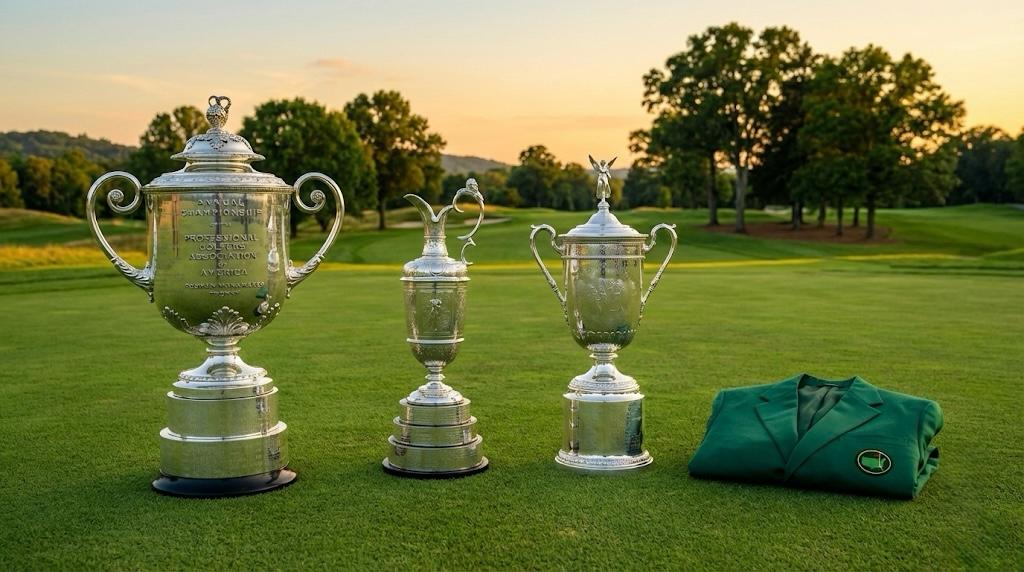
Golf is a sport steeped in tradition, prestige, and class. From the lush greens of the course to the meticulously designed clubs, each aspect of the game exudes a sense of history and elegance. Among these elements, golf trophies – the coveted prizes of the tournament – hold a special place. These iconic awards not only represent the winning golfer’s skill and determination but also carry a rich history and meaningful symbolism. In this article, we’ll delve into the story behind some of the most iconic golf trophies and what they symbolize, offering a unique perspective on this beloved sport.
The Claret Jug: The Open Championship
The Claret Jug, officially known as The Golf Champion Trophy, is awarded to the winner of The Open Championship, one of the four major championships in professional golf. The trophy, first presented in 1873, replaced the original prize of a red leather belt with silver buckle.
Its design is based on the medieval ‘claret jugs’ used to serve wine. The symbolism here lies in the association of the jug with a time-honored tradition, reflecting the essence of the tournament itself. The names of all the previous winners are inscribed on the jug, creating a tangible link to the history of the sport.
The Green Jacket: The Masters Tournament
At The Masters Tournament, one of the most prestigious events in golf, the winner is honored with a distinctive green jacket. The tradition began in 1937 when members of the Augusta National Golf Club wore green jackets to distinguish themselves from the crowd.
The symbolism of the Green Jacket is twofold. Firstly, it represents membership of an exclusive club, as only winners of The Masters or members of the Augusta National Golf Club are entitled to wear it. Secondly, the green color reflects the lush, pristine condition of the golf course, a crucial aspect of the sport.
The Wanamaker Trophy: PGA Championship
The Wanamaker Trophy, awarded to the winner of the PGA Championship, is named after Rodman Wanamaker, who played a significant role in establishing the Professional Golfers’ Association of America. It’s one of the largest trophies in professional golf, standing nearly 2.5 feet tall and weighing 27 pounds.
The size and weight of the Wanamaker Trophy symbolize the magnitude and prestige of the tournament it represents. Moreover, engraved on its silver surface are the names of past champions, honoring the legacy of the game.
The U.S. Open Trophy
The U.S. Open Trophy, awarded to the winner of the U.S. Open, dates back to 1895. The trophy was destroyed in a fire in 1946 and had to be recreated from photographs of the original.
The trophy is a sterling silver cup, adorned with elaborate ornamentation. The names of previous winners are engraved on the base, acknowledging the tournament’s rich history. The trophy represents the pinnacle of achievement in American golf, symbolizing the grit and determination required to prevail in one of the sport’s most challenging competitions.
Golf trophies are more than just symbols of individual triumph; they are embodiments of the rich history, tradition, and enduring spirit of the game. From the Claret Jug’s reflection of time-honored tradition to the Green Jacket’s symbolization of exclusivity and pristine golfing conditions, each trophy carries a unique story and meaning. These iconic awards, while coveted for their prestige, also serve as a timeless reminder of the sport’s enduring allure and the unforgettable moments that define golf history.
-

 Product Review6 years ago
Product Review6 years agoThe Perfect Practice Putting Mat Review by Jason Tenzer
-

 Blog4 years ago
Blog4 years agoLoophole Rule Offers PGA Tour Pros a Mulligan
-

 Blog4 years ago
Blog4 years ago2021 Buyer’s Guide: The Top 10 Value Golf Balls For Distance & Feel
-

 Blog5 years ago
Blog5 years agoGolf Marriage Counselor
-

 Blog6 years ago
Blog6 years ago9 Biggest Chokes Of The Past Decade
-

 Product Review6 years ago
Product Review6 years agoTHE ADJUSTABLE IRONS: WALKING STICKS GOLF CLUBS
-

 Blog4 years ago
Blog4 years agoWhat Your Golf Clubs Say About You
-

 Equipment6 years ago
Equipment6 years agoOHK Sports Interview by Jason Tenzer









